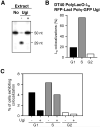Temporal regulation of Ig gene diversification revealed by single-cell imaging
- PMID: 19748985
- PMCID: PMC2859289
- DOI: 10.4049/jimmunol.0900673
Temporal regulation of Ig gene diversification revealed by single-cell imaging
Abstract
Rearranged Ig V regions undergo activation-induced cytidine deaminase (AID)-initiated diversification in sequence to produce either nontemplated or templated mutations, in the related pathways of somatic hypermutation and gene conversion. In chicken DT40 B cells, gene conversion normally predominates, producing mutations templated by adjacent pseudo-V regions, but impairment of gene conversion switches mutagenesis to a nontemplated pathway. We recently showed that the activator, E2A, functions in cis to promote diversification, and that G(1) phase of cell cycle is the critical window for E2A action. By single-cell imaging of stable AID-yellow fluorescent protein transfectants, we now demonstrate that AID-yellow fluorescent protein can stably localize to the nucleus in G(1) phase, but undergoes ubiquitin-dependent proteolysis later in cell cycle. By imaging of DT40 polymerized lactose operator-lambda(R) cells, in which polymerized lactose operator tags the rearranged lambda(R) gene, we show that both the repair polymerase Poleta and the multifunctional factor MRE11/RAD50/NBS1 localize to lambda(R), and that lambda(R)/Poleta colocalizations occur predominately in G(1) phase, when they reflect repair of AID-initiated damage. We find no evidence of induction of gamma-H2AX, the phosphorylated variant histone that is a marker of double-strand breaks, and Ig gene conversion may therefore proceed by a pathway involving templated repair at DNA nicks rather than double-strand breaks. These results lead to a model in which Ig gene conversion initiates and is completed or nearly completed in G(1) phase. AID deaminates ssDNA, and restriction of mutagenesis to G(1) phase would contribute to protecting the genome from off-target attack by AID when DNA replication occurs in S phase.
Figures





Similar articles
-
E2A acts in cis in G1 phase of cell cycle to promote Ig gene diversification.J Immunol. 2009 Jan 1;182(1):408-15. doi: 10.4049/jimmunol.182.1.408. J Immunol. 2009. PMID: 19109172 Free PMC article.
-
Brca1 in immunoglobulin gene conversion and somatic hypermutation.DNA Repair (Amst). 2008 Feb 1;7(2):253-66. doi: 10.1016/j.dnarep.2007.10.002. Epub 2007 Nov 26. DNA Repair (Amst). 2008. PMID: 18036997 Free PMC article.
-
The recruitment of activation induced cytidine deaminase to the immunoglobulin locus by a regulatory element.Mol Immunol. 2010 May;47(9):1860-5. doi: 10.1016/j.molimm.2010.02.025. Epub 2010 Mar 23. Mol Immunol. 2010. PMID: 20334924
-
Activation-induced cytidine deaminase in antibody diversification and chromosome translocation.Adv Cancer Res. 2012;113:167-90. doi: 10.1016/B978-0-12-394280-7.00005-1. Adv Cancer Res. 2012. PMID: 22429855 Free PMC article. Review.
-
Activation-induced cytidine deaminase-mediated hypermutation in the DT40 cell line.Philos Trans R Soc Lond B Biol Sci. 2009 Mar 12;364(1517):639-44. doi: 10.1098/rstb.2008.0202. Philos Trans R Soc Lond B Biol Sci. 2009. PMID: 19008193 Free PMC article. Review.
Cited by
-
The mechanisms regulating the subcellular localization of AID.Nucleus. 2010 Jul-Aug;1(4):325-31. doi: 10.4161/nucl.1.4.12107. Epub 2010 Mar 31. Nucleus. 2010. PMID: 21327080 Free PMC article.
-
Cell Cycle Regulates Nuclear Stability of AID and Determines the Cellular Response to AID.PLoS Genet. 2015 Sep 10;11(9):e1005411. doi: 10.1371/journal.pgen.1005411. eCollection 2015 Sep. PLoS Genet. 2015. PMID: 26355458 Free PMC article.
-
CTNNBL1 is a novel nuclear localization sequence-binding protein that recognizes RNA-splicing factors CDC5L and Prp31.J Biol Chem. 2011 May 13;286(19):17091-102. doi: 10.1074/jbc.M110.208769. Epub 2011 Mar 8. J Biol Chem. 2011. PMID: 21385873 Free PMC article.
-
Competition between PARP-1 and Ku70 control the decision between high-fidelity and mutagenic DNA repair.DNA Repair (Amst). 2011 Mar 7;10(3):338-43. doi: 10.1016/j.dnarep.2010.12.005. Epub 2011 Jan 20. DNA Repair (Amst). 2011. PMID: 21256093 Free PMC article.
-
RAD51 paralogs promote homology-directed repair at diversifying immunoglobulin V regions.BMC Mol Biol. 2009 Oct 28;10:98. doi: 10.1186/1471-2199-10-98. BMC Mol Biol. 2009. PMID: 19863810 Free PMC article.
References
-
- Li Z, Woo CJ, Iglesias-Ussel MD, Ronai D, Scharff MD. The generation of antibody diversity through somatic hypermutation and class switch recombination. Genes Dev. 2004;18:1–11. - PubMed
-
- Maizels N. Immunoglobulin gene diversification. Annu Rev Genet. 2005;39:23–46. - PubMed
-
- Longerich S, Basu U, Alt F, Storb U. AID in somatic hypermutation and class switch recombination. Curr Opin Immunol. 2006;18:164–174. - PubMed
-
- Martomo SA, Gearhart PJ. Somatic hypermutation: subverted DNA repair. Curr Opin Immunol. 2006;18:243–248. - PubMed
-
- Di Noia JM, Neuberger MS. Molecular mechanisms of antibody somatic hypermutation. Annu Rev Biochem. 2007;76:1–22. - PubMed
Publication types
MeSH terms
Substances
Grants and funding
LinkOut - more resources
Full Text Sources
Research Materials
Miscellaneous

